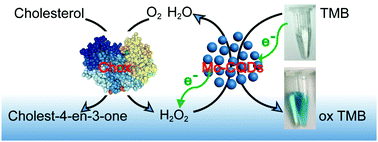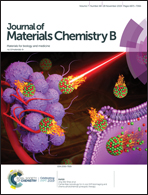High-activity Mo, S co-doped carbon quantum dot nanozyme-based cascade colorimetric biosensor for sensitive detection of cholesterol†
Abstract
Nanozymes have drawn considerable attention because of their lower cost, higher stability and convenient preparation compared to protein enzymes. In the present work, Mo, S co-doped carbon quantum dots (Mo-CQDs) as a peroxidase mimic were used to fabricate a cascade colorimetric biosensor to detect cholesterol. The Mo-CQDs possess a robust peroxidase-like activity, and they can easily catalyze 3,3,5,5-tetramethylbenzidine (TMB) to produce an oxidized TMB in the presence of H2O2. The Mo, S doping in the carbon quantum dots (CQDs) notably boosts the yield of CQDs and may facilitate the electron transfer between TMB and H2O2, which further enhances the catalytic activity of CQDs. The colorimetric biosensor based on Mo-CQDs and cholesterol oxidase exhibited excellent selectivity and high sensitivity for cholesterol in the range of 0.01–1.0 mM along with a detection limit as low as 7 μM. The total cholesterol concentration in the serum sample was measured with satisfactory results and read out by the naked eye, indicating the potential application in clinical diagnosis and portable test kits.



 Please wait while we load your content...
Please wait while we load your content...